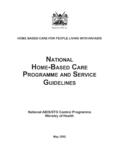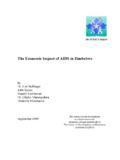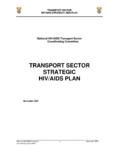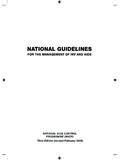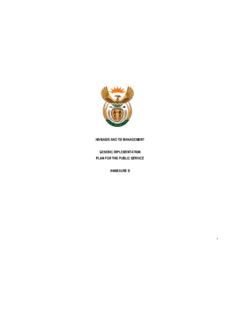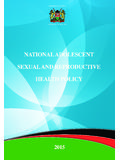Transcription of NATIONAL POLICY ON HIV/AIDS - POLICY Project
1 THE UNITED REPUBLIC OF TANZANIA PRIME MINISTER S OFFICE NATIONAL POLICY ON HIV/AIDS Dar es Salaam September 2001 iTHE UNITED REPUBLIC OF TANZANIA PRIME MINISTER S OFFICE NATIONAL POLICY ON HIV/AIDS 2001 TABLE OF CONTENTS Topic Page No Acronyms iv Foreword v BACKGROUND 1 Impact of HIV/AIDS 1 HIV/AIDS and Poverty 1 Stigma and HIV/AIDS 2 Financing NATIONAL response to HIV/AIDS 2 Political and Government Commitment and Leadership 3 Justification for the NATIONAL POLICY on HIV/AIDS 3 Principles to guide the NATIONAL POLICY on HIV/AIDS 5 HIV/AIDS SITUATION 8 The Current Situation 8 Modes of Transmission of HIV/AIDS 8 The risk of HIV Infection 9 OVERALL GOALS OF THE POLICY 10 Introduction 10 Specific Objectives of the POLICY 10 a) Prevention of the transmission of HIV/AIDS 10 b) HIV Testing 11 c) Care for PLHAs 11 d) Sectoral Roles and Financing 12 e) Research 13 f) Legislation and Legal Issues 13 g)
2 Other Objectives 14 RIGHTS OF PERSONS LIVING WITH HIV/AIDS AND THE RIGHTS OF THE PUBLIC 15 Objective 15 PREVENTION OF HIV SEXUAL TRANSMISSION 17 Objective 17 For Youth in Schools and Institutions of Higher Learning 17 For Out of School Youth 18 For Adults 18 For People with Multiple Partners 18 For drug abusers 19 For PLHAs 19 Media Institutions 19 Community Involvement 19 Condoms 20 Prevention and Management of STIs 20 Transmission through blood donors and blood products, donated organs, tissues and body fluids 20 Transmission through invasive and non invasive 21 skin penetration surgical, dental and cosmetic procedures a) Use of sterile disposable re-useable Equipment 22 and accidental Injuries b) Education for users of cosmetic and health services 23 Prevention of mother to child transmission (MTCT) of HIV 23 a) Prenatal Transmission 24 b) Intra-partum Transmission 24 c)
3 Postnatal Transmission 24 Gender Issues in Relation to HIV/AIDS 25 HIV TESTING 27 Objective 27 Testing for HIV/AIDS 27 Confidentiality 27 Informed Consent 28 Partner Notification 28 Criminalisation of Wilful spread of HIV infection 29 Pre-marital HIV Testing 29 Research Involving HIV Testing 29 Surveillance for HIV 29 Cost of HIV Testing 30 HIV Testing during pregnancy 30 CARE FOR PEOPLE LIVING WITH HIV/AIDS 31 Objective 31 Community Based Care and support Services 32 Protection Of Health Care Workers 33 iv Support Services 34 RESEARCH 36 Introduction 36 Procedures of HIV/AIDS Research 36 NATIONAL HIV/AIDS Research Priorities 37 Dissemination of Research Findings 37 Funding of aids Research 38 SECTORAL ROLES AND FINANCING 39 Objective 39 INSTITUTIONAL AND ORGANIZATIONAL STRUCTURE 41 OF THE TANZANIA COMMISSION FOR aids (TACAIDS)
4 Introduction 41 Vision 41 Mission 41 Goal 41 Objectives 42 Functions of the Commission 42 POLICY 43 v ACRONYMS aids Acquired Immuno-Deficiency Syndrome ART Anti-Retroviral Therapy CBO Community Based Organisation HAARD Highly Active Anti-Retroviral Drugs HAART Highly Active Anti-Retroviral Therapy HIV Human Immunodeficiency Virus IEC Information, Education and Communication ICPD International Conference on Population and Development MTCT Maternal To Child Transmission MTP Medium Term Plan NACP NATIONAL aids Control Programme NGOs Non Governmental Organisations STIs Sexually Transmitted Infections STP Short Term Plan TACAIDS Tanzania Commission for aids CHAPTER 1 BACKGROUND Impact of HIV/AIDS HIV/AIDS is a major development crisis that affects all sectors.
5 During the last two decades the HIV/AIDS epidemic has spread relentlessly affecting people in all walks of life and decimating the most productive segments of the population particularly women and men between the ages of 20 and 49 years. The increasing number of aids related absenteeism from workplaces and deaths reflects the early manifestation of the epidemic leaving behind suffering and grief. Others include lowering of life expectancy, increasing the dependency ratio, reducing growth in GDP, reduction in productivity, increasing poverty, raising infant and child mortality as well as the growing numbers of orphans. The children under the age of ten years bear the brunt of the impact of aids and for them the impact is much longer lasting than for adults.
6 The epidemic is a serious threat to the country s social and economic development and has serious and direct implications on the social services and welfare. Given the high HIV prevalence in the society, and in the absence of cure, the devastating impact of the epidemic is incomprehensible. HIV/AIDS and Poverty It has been well established that poverty significantly influences the spread and impact of HIV/AIDS . In many ways it creates vulnerability to HIV infection, causes rapid progression of the infection in the individual due to malnutrition and limits access to social and health care services. Poverty causes impoverishment as it leads to death of the economically active segments of the society and bread winners leading to reduction in income or production.
7 The human capital loss has serious social and economic development in all sectors and at all levels. Ultimately the high cost of care and burials leave heavy burden on the already overburdened households, orphans and dependants, People Living With HIV/AIDS (PLHAs) and vulnerability to HIV infection. Therefore the poverty factor at the household level has to be addressed simultaneously with the NATIONAL efforts to combat the HIV/AIDS epidemic. Stigma and HIV/AIDS HIV/AIDS related stigma is one of the key challenges in the prevention and control of the epidemic. In Tanzania, like in other countries in south of the Sahara, stigma against HIV/AIDS remains very strong and plays a major role in fuelling HIV infection.
8 In our community HIV related stigma tends to be firmly linked in peoples minds to sexual behaviour which again is regarded as promiscuous behaviour. This attitude puts PLHAs into unnecessary hostile and embarrassing situation, they face discrimination and sometimes neglect. Worse still, stigma leads to secrecy and denial that tends to hinder openness about the HIV and prevents people from seeking counselling and testing for HIV. This leaves hundreds of thousands of apparently healthy looking people who are infected with HIV transmitting the infection to hundreds of thousands of uninfected people. Therefore in fighting the epidemic, every effort shall be put into breaking the long deadly silence on HIV/AIDS by all sectors at all levels.
9 This involves health workers, political and government leaders, religious leaders, NGOs, PLHAs, community leaders and families. Financing NATIONAL response to HIV/AIDS The Government has the responsibility to provide management and financial leadership in the NATIONAL response to the HIV/AIDS epidemic. The Government has allocated US$ 8 million for HIV/AIDS activities for the fiscal year 2001/2002 and all sectors and councils are implementing HIV/AIDS interventions. However, given the overwhelming high cost involved, it is beyond the capacity of the Government to provide adequate funds for the NATIONAL response programme.
10 Therefore development partners and the private sector also share the responsibility and moral obligation to complement the Government efforts. In view of the large numbers of PLHAs, and the critical importance of community based interventions including home care and support to orphans and PLHAs the communities will need financial and moral support to carry out the interventions. However, considering the poor economic situation in the local councils and communities, and particularly in the households, modalities must be found to mobilise funds for the support of the community based interventions. Consideration will be given to establishing aids Trust Fund to complement community based interventions through the local councils.


